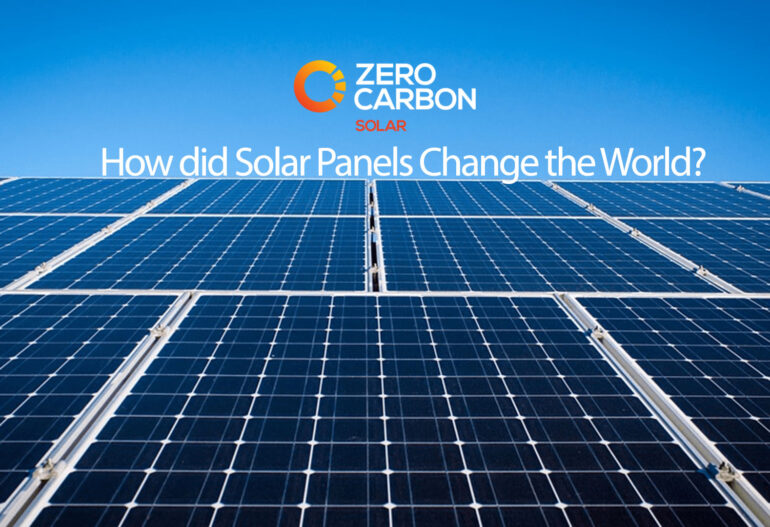Solar energy is generated from the light of the sun. It is source of energy that can be renewed itself and is free of cost. It does not release greenhouse gases or other harmful by-products. With the help of silicon cells, the light coming from the sun is converted into energy or electricity. Today, solar energy is used all around the globe for heating water, cooking food, cooling, lighting, and even power vehicles. You will be interesting to know how did solar panels change the world? We will answer it in details.
Can we expect solar energy for every household by 2050?
Raising the question, how did solar panels change the world? A lot of experts believe it is the best alternative for the use of fossil fuels to generate electricity and it will provide electricity to almost every part of the world by 2050. They also estimated that the amount of solar irradiation the Earth receives is 20,000 times more than the population consumes.
Solar power protects water resources
The following points describe, how did solar panels change the world? Climate change is one of the biggest changes due to solar panels as they do not emit any harmful gases thus it gives humans a clean environment. Solar power brought a big change in the protection of water resources as it does not contaminate water unlike, fossil fuels.
Solar power creates jobs around the world
It is reaching in developing countries with fast pace around the world as it is cheaper and requires less infrastructure. It is also providing jobs in the renewable energy sector and in the near future unemployment might eradicate.
What is average solar irradiation?
At any given moment, the Sun transmits 1367 Watts per m² into the Earth’s orbit. The average solar irradiation is, in some western latitudes, about 1000 watts / m2. This means that the amount of energy radiated from the Sun to Earth is enormous and could cover the world’s energy needs.
One of the advantages of photovoltaic panels is that light is converted directly into electricity. This conversion takes place cleanly, i.e. without the release of CO2 into the environment and fine dust.
The cells of photovoltaic modules are made up mostly of silicon, one of the most common materials on Earth.
How is the Sun’s energy transformed into electricity?
Solar photovoltaic allows you to transform energy with the Sun into electricity directly and instantly without using fuels.
Photovoltaic systems can be isolated from the electricity grid, such as some mountain huts, water pumping systems, road signaling systems, etc. or they can be connected to the mains.
Solar energy is an infinite resource. At least until the Sun goes out, we can use the energy that arrives on our planet. The binomial Sun and energy, i.e the amount of solar energy produced by the solar source, would be able to meet our need for total energy.
Cost cutting in bills through solar panels
The cost of photovoltaic systems is low compared to that of other energy supply systems. If the initial cost may be high, it is true that the return is guaranteed within 5, 10 years, after which you will be able to take advantage of a nice cost cut in the bill.
In addition to photovoltaic solar systems, which transform light into electricity, there are solar thermal systems, which use the sun’s rays to heat a fluid that can be used to heat homes and buildings. Thermodynamic solar systems combine the two modes. There is therefore the possibility of a varied use of solar energy.
On our planet, the reserves of non-renewable fuels are not unlimited and on the contrary, their regeneration takes quite a long time. The use of non-renewable energies is also often associated with environmental pollution phenomena.
On the contrary, renewable energy sources are non-exhaustible and alternative forms of energy. Among the renewable energy sources (also called alternative energy sources to distinguish them from non-renewable and traditional ones) there are wind, sun, water and geothermal resources, tides and biomass, or the transformation of organic products into energy electric.
Control over Environmental Damage
With the increasing demand for energy which is constantly growing, the reserves of non-renewable sources tend to run out while their combustion and excessive exploitation increases environmental damage.
Renewable energies, because they come from energy sources that belong to the physical structure of our planet, are constantly renewed and reproduced by natural elements, therefore they are not subject to exhaustion.
Future of energy
Renewable sources represent the future of energy and are the ecological alternative pursued by most nations, in a more or less incisive way. That’s the best answer of “how did solar panels change the world”.
The climate change and global warming require greater attention in the direction of safeguarding the overall situation of the environment and human health. The main advantage of producing energy from renewable sources, however, concerns not only the benefits for the environment, but also the stability they are able to guarantee over time.
Conclusion:
Concluding the topic with an answer to the question, how did solar panels change the world? With solar the world can become a better place to live as people will save money and energy and the environment will be pollution-free.
You can also read the following most famous articles:




